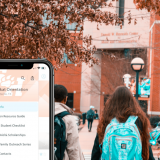Building Relationships with Students Using Mobile Technology
The following post is part of a series on Digital Leadership in Higher Ed with GuidebookEDU’s Digital Leadership Partner, Josie Ahlquist.
How can ed tech vendors evolve because of their partnerships with schools?
When ACPA/NASPA published their Technology Competencies in 2015, we realized that it had implications for our company even though we may not be directly considered Student Affairs professionals. But as a company that supplies an increasingly important channel of communication to Student Affairs professionals – this seemed like an important step forward and a chance to align the methodology of vendors with the institutions they support.
For the first time, we could clearly see standardized technology outcomes and ask ourselves the question, “Where do we fit in here?” It’s the very reason Josie Ahlquist’s work caught our attention and this blog series came to fruition.
As a company that provides mobile app technology to universities, it’s been our job to internalize certain truths that pretty much anyone walking around a college campus today could observe for themselves. The vast majority of university students have smartphones. They expect communication to be instant, mobile and personal. Digital sharing is high praise. For us, the puzzle becomes one of finding a connection between the goals of Student Affairs professionals and the preferred student communication habits we’re observing.
Breaking up communication into units
Where we’ve settled is an assembly of use cases and complementing features that serve each stage of the student lifecycle. In the same way that Student Affairs attempts to holistically nurture a student at each stage in their higher ed journey, we’re attempting to make it easier by knocking down communication barriers along that path.
In the simplest sense, our most successful app implementations have been ones where we help a university centralize their communication into one mobile resource. A singular branded app is deployed to the app stores on behalf of the university, and they are free to publish content to that app in the form of individual units or – as we call them – guides. (Watch a video about how NC State accomplished this.) Guides cover events, offices, and key milestones in student life – and thus service key communication points along the student journey.
Where we start
Our style is to take our cues from our clients. They know best, after all, because they’re on campus interacting with students every day. If I had to boil down the three main things we’re told over and over when we listen to clients it would be:
- Email can no longer be considered a reliable delivery channel. Students may or may not open emails – and they tend to stick to their personal accounts.
- Social media is great for developing community but – again – isn’t reliable for relating important information. And many administrators are finding that networks where we spent a lot of time building up equity are losing younger users in droves (here’s looking at you, Facebook).
- People come to us because they’re looking for the one killer communication channel.
That last point is something that we’ve taken very seriously. As an app company, we know the power that a native app carries and that – if implemented correctly – it can very well provide that centralized communication channel higher ed professionals are hoping for. But since implementing an app is a new experience for most people, we’ve found that helping people along with that process is just as much a part of our responsibility as providing the software.
So once we combine the difficulties higher ed professionals are expressing to us with our strengths as app developers, we can narrow down on some core competencies that we need to provide our clients:
- Make a user-centric content delivery system. Design is extremely important at Guidebook, and so we’ve invested a lot of time and resources into making sure that when a person does use one of our apps it’s a pleasant experience. In higher ed, it’s very similar to espousing a “students first” mentality.
- Make a centralized place where disparate content can cohabitate. A university is a complex community built of many building blocks with different functions. Our job is to help provide a space where they can all reach their audiences simultaneously.
- Make it easy to manage the content. We’re trying to bring app building to the masses, so it wouldn’t make sense to have a complicated process in place in order to create an app or keep it up to date. With our content management system, we’ve tried to take the friction out of app management.
- Make student feedback accessible. Unlike email and social media, apps can give administrators all sorts of detailed feedback on how students are interacting with content. Unlocking that data gives you the power to iterate and communicate better all the time.
Mapping out the student lifecycle
As we’ve grown along with our client base, they’ve actually done a lot to show us how our product can be used. Using the stages of the student lifecycle as a cue, we’ve discovered that the need for effective communication doesn’t stop after those first few weeks a new student steps on campus. As a result, our clients have shown us how app communication can extend throughout those four years (and beyond).
- Prospective students – Before a student is a student, they’re making important decisions about where they want to attend school. And important decisions require a lot of precise communication. That inspired us to build an entire product – Campus Tours – which facilitates the delivery of the all-important campus visit.
- New students – The communication a new student receives is key when it comes to student satisfaction, happiness, and retention. Most universities being their mobile journey with us in order to improve the communication they’re distributing in this phase.
- Mid-career students – When students have been primed to seek out information within their campus apps, we’ve found that they then expect similar communications from campus offices, services and events. For this reason, we’ve seen a rise in apps for homecomings, health centers, and even career fairs.
- Graduating students and Alumni – Staying in the loop doesn’t stop at graduation – and we’re now graduating students who came of age with mobile technology in hand. As a result, we see our clients providing apps for commencements and Alumni offices.
Campuses with this sort of complete mobile communication cycle have recognized that consistency and immediacy of communication channel are key, and through our partnerships with these institutions we’ve worked to stay flexible in order to support the entire student lifecycle.
If you build it…
One of our most collaborative discoveries when working with higher ed institutions has been perfecting the process around app adoption at schools. Just providing the resource and hoping students will use it never ends up bearing productive fruit. Providing an app as a resource is an inherently active move, but just like any other new initiative – it requires a distribution and marketing strategy.
We’ve listened closely to our campus partners on this one. I think back to my conversations with Keith Frazee, Assistant Director of Orientation Programs at Oregon State, who happens to have a star app implementation. Keith recognized early on that he needed a communication strategy in order for his app to be successful. He put the building of the app into the hands of his capable student leaders, and he focused on lobbying for support across campus with other internal stakeholders and figuring out how to change existing paradigms in order to accommodate a new mobile app channel. As a result, he’s seeing more than 100% adoption on each of his orientation apps.
From partners like Keith, we’ve learned that early app adoption is key – especially if you’re relying on an app to stick for the rest of that student’s lifecycle as discussed earlier. What’s resulted is a list of best practices that can then be shared out with our future partners – growing and enhancing processes along the way.
Always think about how to to add value to the student experience
If a student opens an app and finds it immediately useful, you’ve hooked them.
Simplify communication by subtraction and consolidation
Tools that are simple and self-explanatory hold our attention and minimize frustration. One central app that houses answers to all my questions becomes an invaluable resource.
Strategize with other campus partners
Providing an app that has buy-in from across campus only enhances the value of the content inside. If you believe in mobile communication, lobby for it to become a standard across departments.
Rely on your technology partners to help you implement
Businesses like ourselves have learned a lot from working with wide varieties of vertical populations. At a company like Guidebook, we work with all sorts of institutions and are happy to share knowledge across industries to help you improve.
So as a company that provides technology to higher ed, we feel as though it’s our duty to truly partner with schools – not just sell them a product. We hope that through our partnerships with industry leaders like Josie Ahlquist and the schools we continue to work with, we will continue to develop and refine effective communication channels for educators. As you work to espouse the Advanced Outcomes of the Technology Competencies, we hope to give you the tools to make them a reality.
You can try out Guidebook’s technology today for free. Try building an app and see what it’s like to truly partner with a technology company!


